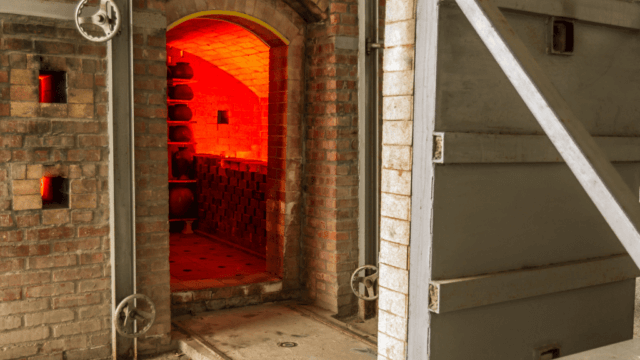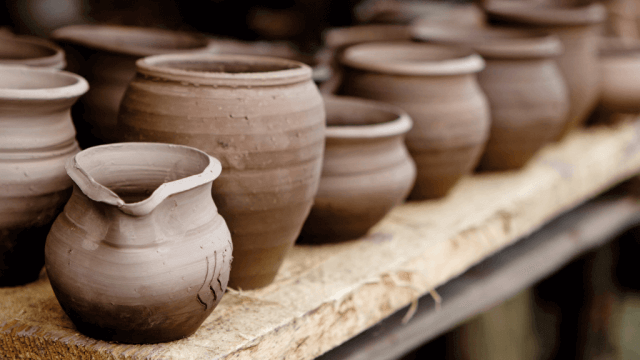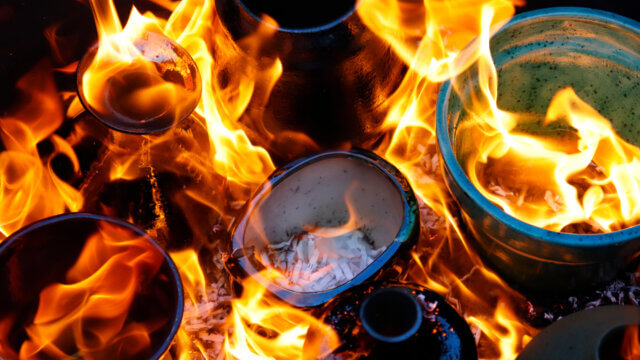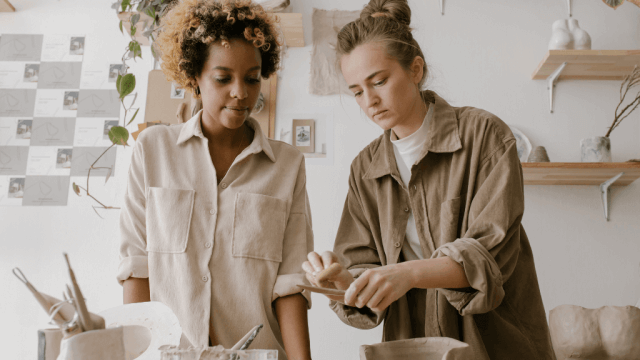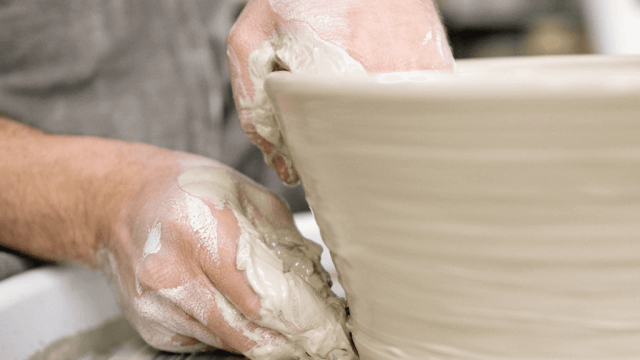To fire pottery without a kiln, you can use alternative methods such as pit firing, bonfire, or the sawdust firing technique.
Pit firing involves digging a hole, placing the pottery pieces inside, covering them with combustible materials, and igniting them.
Bonfire firing is done by building a fire around the pottery, feeding it slowly and steadily until it reaches a desired temperature.
Lastly, sawdust firing requires packing a container with sawdust, embedding your pottery pieces, adding some combustible material, and igniting to create a controlled burn.
Firing Pottery Without a Kiln
Several methods to fire pottery without a kiln produce unique, beautiful results.
This blog post will explore three traditional techniques: pit firing, bonfire firing, and sawdust firing.
Pit Firing Technique
Pit firing is an ancient pottery firing technique that uses an earthen hole to create low-fire ware.
Step 1: Dig a pit
Locate a suitable area for pit firing and dig a hole in the ground, large enough to accommodate all your pottery pieces with some space around each.
Step 2: Prepare pottery
Allow the pottery pieces to air dry completely.
Ensure they are free from moisture as sudden temperature changes can cause cracking.
Step 3: Layer combustibles
In the pit, create layers of combustible material, starting with large wood logs, followed by twigs, leaves, grass, and finally, sawdust.
Alternate each pottery piece with combustible layers, making sure they are not touching.
Step 4: Ignite the fire and let it burn
Ignite the materials and allow them to burn for several hours.
After the fire subsides, let the pottery cool down for 24 hours or more before digging it out and cleaning it up.
Keep in mind that this method is not suitable for functional ceramics.
Bonfire Firing Technique
Bonfire firing involves creating a large bonfire and placing your pottery pieces in and around the fire to achieve low-fire pottery ware.
Step 1: Build the bonfire
Prepare a bonfire using wood logs and kindling materials.
Once the fire is burning well, carefully place the pottery pieces around the bonfire, ensuring they are well surrounded by the flames.
Step 2: Manage the temperature
Monitor and manage the fire by slowly adding more wood to increase the temperature gradually.
Let the bonfire burn for about 2-3 hours for the desired temperature and effect.
Step 3: Cool down and clean up
Allow the pottery pieces to cool down completely before handling.
Be prepared for unique and unexpected results, including color variations and patterns on your pottery.
Sawdust Firing Technique
Sawdust firing entails encasing pottery in sawdust and igniting it to create a controlled burn for low-fire ware.
Step 1: Prepare a container
Select a large, fireproof container such as a metal drum, and ensure it has good ventilation.
Add a layer of sawdust at the bottom of the container.
Step 2: Position the pottery
Place your pottery pieces on the sawdust layer, ensuring each piece has some space around it.
Fill the remaining areas with more sawdust, covering the pottery completely.
Step 3: Ignite the sawdust
Add kindling materials such as paper or dry leaves, and ignite the sawdust.
Once alight, the sawdust will smolder, raising the temperature slowly.
This method takes several hours, and the pottery should be left to cool for at least 24 hours before processing.
Barrel Firing Technique
Barrel firing is another alternative to kiln firing, using a metal barrel to create low-fire pottery.
This method provides both a reduction atmosphere and an opportunity for interesting surface effects.
Step 1: Prepare the barrel
Choose a metal barrel with a lid, and drill several ventilation holes near the bottom for airflow.
Create a layer of wood, kindling, and paper at the bottom of the barrel.
Step 2: Position the pottery
Place your pottery pieces onto the initial layer, ensuring they are not touching each other.
Continue layering combustible material, such as wood or sawdust, around the pottery.
Step 3: Burn and monitor
Ignite the contents of the barrel, making sure to monitor the fire.
Close the lid, but leave a small gap for airflow.
Depending on the size of the barrel and amount of pottery, the burn may last between 3 to 5 hours.
Step 4: Cool and clean
Allow the barrel and pottery to cool completely before handling, which can take up to 24 hours.
Carefully remove your pottery and clean off any ash residue.
Be prepared for unique markings and effects that develop during the firing process.
Tips for Alternative Firing Techniques
Whether you’re new to alternative firing techniques or experienced, these tips can help improve your results:
- Choose the right clay: Use clay bodies specifically formulated for low-fire techniques, such as terra cotta or earthenware, as they are more resistant to cracking during rapid temperature changes.
- Preheat the pottery: Exposing your pottery to gentle heat from the sun or a heating pad before the firing process can help reduce moisture content and minimize the risk of cracks.
- Add colorants and decorations: Experiment with various colorants like metal oxides or slips to create unique surface effects and patterns during alternative firing processes.
- Use combustible materials: Adding combustible materials like straw, wood shavings, or pine needles can create captivating patterns and effects during the burning process.
- Embrace the unpredictability: One of the most significant advantages of alternative firing techniques is the range of unique, unpredictable results.
Enjoy the process, experiment with different approaches, and learn from each firing experience.
Remember that these alternative methods may not always produce functional ware or food-safe pottery.
Treat these techniques as an opportunity for artistic exploration and experimentation in ceramics.
FAQ Section: Firing Pottery Without a Kiln
In this section, we address common questions regarding alternative firing techniques for pottery.
These concise explanations provide quick insights into the most frequently asked queries on this topic.
Can I fire pottery at home without a kiln?
Yes, you can fire pottery at home without a kiln using alternative methods such as pit firing, bonfire firing, sawdust firing, or barrel firing.
These techniques create unique, low-fire pottery ware but may not produce functional or food-safe ceramics.
What type of clay is best for alternative firing methods?
Earthenware or terra cotta clay bodies are the most suitable for alternative firing methods.
These types of clays mature at a lower temperature and are more resistant to thermal shock, which reduces the risk of cracking during rapid temperature changes.
Are alternative firing techniques food-safe?
Alternative firing techniques cannot guarantee food-safe ceramics as they generally produce low-fire pottery and do not reach the necessary temperatures for vitrification.
Additionally, the irregular and varying atmospheres during these firing methods can impact glazes and affect food safety.
How long does it take to fire pottery without a kiln?
The duration for firing pottery without a kiln varies depending on the alternative method used.
Generally, it takes several hours for the firing process and an additional 24 hours or more for the pottery to cool down before it can be handled and cleaned.
Can I glaze pottery fired without a kiln?
It is possible to apply low-fire glazes to pottery fired without a kiln.
However, due to the unpredictable nature and temperatures reached during alternative firing methods, the final results may vary.
It is essential to experiment and test your glazes to achieve the desired outcome and ensure compatibility with the chosen firing method.

